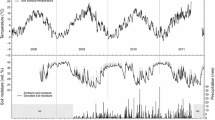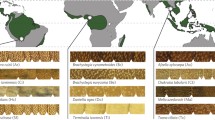Abstract
Carbon uptake by forests constitutes half of the planet’s terrestrial net primary production; therefore, photosynthetic responses of trees to rising atmospheric CO2 are critical to understanding the future global carbon cycle. At the Swiss Canopy Crane, we investigated gas exchange characteristics and leaf traits in five deciduous tree species during their eighth growing season under free air carbon dioxide enrichment in a 35-m tall, ca. 100-year-old mixed forest. Net photosynthesis of upper-canopy foliage was 48% (July) and 42% (September) higher in CO2-enriched trees and showed no sign of down-regulation. Elevated CO2 had no effect on carboxylation efficiency (V cmax) or maximal electron transport (J max) driving ribulose-1,5-bisphosphate (RuBP) regeneration. CO2 enrichment improved nitrogen use efficiency, but did not affect leaf nitrogen (N) concentration, leaf thickness or specific leaf area except for one species. Non-structural carbohydrates accumulated more strongly in leaves grown under elevated CO2 (largely driven by Quercus). Because leaf area index did not change, the CO2-driven stimulation of photosynthesis in these trees may persist in the upper canopy under future atmospheric CO2 concentrations without reductions in photosynthetic capacity. However, given the lack of growth stimulation, the fate of the additionally assimilated carbon remains uncertain.




Similar content being viewed by others
Abbreviations
- A growth :
-
Light-saturated net photosynthesis measured at growth CO2 concentration (ambient CO2: A agrowth ; elevated CO2: A egrowth )
- A 550 :
-
Light-saturated net photosynthesis measured at 550 ppm leaf chamber CO2 concentration
- A 380 :
-
Light-saturated net photosynthesis measured at 380 ppm leaf chamber CO2 concentration
- C:
-
Carbon
- E :
-
A egrowth /A agrowth
- E′:
-
A 550 /A 380
- FACE:
-
Free air carbon dioxide enrichment
- J max :
-
Maximal photosynthetic electron transport rate (a proxy for ribulose-1,5-bisphosphate regeneration)
- LAI:
-
Leaf area index
- N:
-
Nitrogen
- PPFD:
-
Photosynthetic photon flux density
- SLA:
-
Specific leaf area
- NSC:
-
Non-structural carbohydrates
- SCC:
-
Swiss canopy crane
- SE:
-
Standard error of the mean
- V cmax :
-
Maximal carboxylation rate of Rubisco
- ALVPD:
-
Air-to-leaf vapour pressure deficit
References
Adam NR, Wall GW, Kimball BA, Idso SB, Webber AN (2004) Photosynthetic down-regulation over long-term CO2 enrichment in leaves of sour orange (Citrus aurantium) trees. New Phytol 163:341–347
Ainsworth EA, Long SP (2005) What have we learned from 15 years of free-air CO2 enrichment (FACE)? A meta-analytic review of the responses of photosynthesis, canopy properties and plant production to rising CO2. New Phytol 165:351–371
Ainsworth EA, Rogers A (2007) The response of photosynthesis and stomatal conductance to rising CO2: mechanisms and environmental interactions. Plant Cell Environ 30:258–270
Asshoff R, Zotz G, Körner C (2006) Growth and phenology of mature temperate forest trees in elevated CO2. Glob Change Biol 12:848–861
Bader M, Körner C (2010) No overall stimulation of soil respiration under mature deciduous forest trees after 7 years of CO2 enrichment. Glob Change Biol. doi:10.1111/j.1365-2486.2010.02159.x (in press)
Bader M, Hiltbrunner E, Körner C (2009) Fine root responses of mature deciduous forest trees to free air carbon dioxide enrichment (FACE). Funct Ecol 23:913–921
Bonan GB (2008) Forests and climate change: forcings, feedbacks, and the climate benefits of forests. Science 320:1444–1449
Cech PG, Pepin S, Körner C (2003) Elevated CO2 reduces sap flux in mature deciduous forest trees. Oecologia 137:258–268
Crous KY, Walters MB, Ellsworth DS (2008) Elevated CO2 concentration affects leaf photosynthesis–nitrogen relationships in Pinus taeda over nine years in FACE. Tree Physiol 28:607–614
Curtis PS, Wang XZ (1998) A meta-analysis of elevated CO2 effects on woody plant mass, form, and physiology. Oecologia 113:299–313
Drake BG, Gonzalez-Meler MA, Long SP (1997) More efficient plants: a consequence of rising atmospheric CO2? Annu Rev Plant Physiol Plant Mol Biol 48:609–639
Egli P, Maurer S, Spinnler D, Landolt W, Gunthardt-Georg MS, Körner C (2001) Downward adjustment of carbon fluxes at the biochemical, leaf, and ecosystem scale in beech-spruce model communities exposed to long-term atmospheric CO2 enrichment. Oikos 92:279–290
Ellsworth DS, Reich PB, Naumburg ES, Koch GW, Kubiske ME, Smith SD (2004) Photosynthesis, carboxylation and leaf nitrogen responses of 16 species to elevated pCO2 across four free-air CO2 enrichment experiments in forest, grassland and desert. Glob Change Biol 10:2121–2138
Farquhar GD, von Caemmerer S, Berry JA (1980) A biochemical model of photosynthetic CO2 assimilation in leaves of C3 species. Planta 149:78–90
Gielen B, Liberloo M, Bogaert J, Calfapietra C, De Angelis P, Miglietta F, Scarascia-Mugnozza G, Ceulemans R (2003) Three years of free-air CO2 enrichment (POPFACE) only slightly affect profiles of light and leaf characteristics in closed canopies of Populus. Glob Change Biol 9:1022–1037
Gunderson CA, Wullschleger SD (1994) Photosynthetic acclimation in trees to rising atmospheric CO2—a broader perspective. Photosynth Res 39:369–388
Gunderson CA, Sholtis JD, Wullschleger SD, Tissue DT, Hanson PJ, Norby RJ (2002) Environmental and stomatal control of photosynthetic enhancement in the canopy of a sweetgum (Liquidambar styraciflua L.) plantation during 3 years of CO2 enrichment. Plant Cell Environ 25:379–393
Hättenschwiler S, Miglietta F, Raschi A, Körner C (1997) Thirty years of in situ tree growth under elevated CO2: a model for future forest responses? Glob Change Biol 3:463–471
Herrick JD, Thomas RB (2001) No photosynthetic down-regulation in sweetgum trees (Liquidambar styraciflua L.) after three years of CO2 enrichment at the Duke forest FACE experiment. Plant Cell Environ 24:53–64
Keel SG, Siegwolf RTW, Körner C (2006) Canopy CO2 enrichment permits tracing the fate of recently assimilated carbon in a mature deciduous forest. New Phytol 172:319–329
Körner C (2006) Plant CO2 responses: an issue of definition, time and resource supply. New Phytol 172:393–411
Körner C, Miglietta F (1994) Long-term effects of naturally elevated CO2 on mediterranean grassland and forest trees. Oecologia 99:343–351
Körner C, Asshoff R, Bignucolo O, Hättenschwiler S, Keel SG, Pelaez-Riedl S, Pepin S, Siegwolf RTW, Zotz G (2005) Carbon flux and growth in mature deciduous forest trees exposed to elevated CO2. Science 309:1360–1362
Le Quéré C, Raupach MR, Canadell JG, Marland G, Bopp L, Ciais P, Conway TJ, Doney SC, Feely RA, Foster P, Friedlingstein P, Gurney K, Houghton RA, House JI, Huntingford C, Levy PE, Lomas MR, Majkut J, Metzl N, Ometto JP, Peters GP, Prentice IC, Randerson JT, Running SW, Sarmiento JL, Schuster U, Sitch S, Takahashi T, Viovy N, van der Werf GR, Woodward FI (2009) Trends in the sources and sinks of carbon dioxide. Nat Geosci 2:421–436
Leuzinger S, Körner C (2007) Water savings in mature deciduous forest trees under elevated CO2. Glob Change Biol 13:2498–2508
Liberloo M, Tulva I, Raim O, Kull O, Ceulemans R (2007) Photosynthetic stimulation under long-term CO2 enrichment and fertilization is sustained across a closed Populus canopy profile (EUROFACE). New Phytol 173:537–549
Long SP, Bernacchi CJ (2003) Gas exchange measurements, what can they tell us about the underlying limitations to photosynthesis? Procedures and sources of error. J Exp Bot 54:2393–2401
Long SP, Ainsworth EA, Rogers A, Ort DR (2004) Rising atmospheric carbon dioxide: plants face the future. Annu Rev Plant Biol 55:591–628
Medlyn BE, Badeck FW, De Pury DGG, Barton CVM, Broadmeadow M, Ceulemans R, De Angelis P, Forstreuter M, Jach ME, Kellomaki S, Laitat E, Marek M, Philippot S, Rey A, Strassemeyer J, Laitinen K, Liozon R, Portier B, Roberntz P, Wang K, Jarvis PG (1999) Effects of elevated CO2 on photosynthesis in European forest species: a meta-analysis of model parameters. Plant Cell Environ 22:1475–1495
Moore BD, Cheng SH, Sims D, Seemann JR (1999) The biochemical and molecular basis for photosynthetic acclimation to elevated atmospheric CO2. Plant Cell Environ 22:567–582
Noormets A, McDonald EP, Dickson RE, Kruger EL, Sober A, Isebrands JG, Karnosky DF (2001) The effect of elevated carbon dioxide and ozone on leaf- and branch-level photosynthesis and potential plant-level carbon gain in aspen. Trees Struct Funct 15:262–270
Norby RJ, Wullschleger SD, Gunderson CA, Johnson DW, Ceulemans R (1999) Tree responses to rising CO2 in field experiments: implications for the future forest. Plant Cell Environ 22:683–714
Norby RJ, Sholtis JD, Gunderson CA, Jawdy SS (2003) Leaf dynamics of a deciduous forest canopy: no response to elevated CO2. Oecologia 136:574–584
Nowak RS, Ellsworth DS, Smith SD (2004) Functional responses of plants to elevated atmospheric CO2—do photosynthetic and productivity data from FACE experiments support early predictions? New Phytol 162:253–280
Oren R, Ellsworth DS, Johnsen KH, Phillips N, Ewers BE, Maier C, Schäfer KVR, McCarthy H, Hendrey G, Mcnulty SG, Katul GG (2001) Soil fertility limits carbon sequestration by forest ecosystems in a CO2-enriched atmosphere. Nature 411:469–472
Pepin S, Körner C (2002) Web-FACE: a new canopy free-air CO2 enrichment system for tall trees in mature forests. Oecologia 133:1–9
Rogers A, Ellsworth DS (2002) Photosynthetic acclimation of Pinus taeda (loblolly pine) to long-term growth in elevated pCO2 (FACE). Plant Cell Environ 25:851–858
Roy J, Saugier B, Mooney HA (2001) Terrestrial global productivity. Academic Press, San Diego
Sabine CL, Heimann M, Artaxo P, Bakker DCE, Chen C-TA, Field CB, Gruber N, Le Quéré C, Prinn RG, Richey JE, Lankao PR, Sathaye JA, Valentini R (2004) Current status and past trends of the global carbon cycle. In: Field CB, Raupach MR (eds) Global carbon cycle—integrating humans climate and the natural world. Island Press, Washington, DC, pp 17–44
Saxe H, Ellsworth DS, Heath J (1998) Tree and forest functioning in an enriched CO2 atmosphere. New Phytol 139:395–436
Schimel DS (1995) Terrestrial ecosystems and the carbon cycle. Glob Change Biol 1:77–91
Sholtis JD, Gunderson CA, Norby RJ, Tissue DT (2004) Persistent stimulation of photosynthesis by elevated CO2 in a sweetgum (Liquidambar styraciflua) forest stand. New Phytol 162:343–354
Stitt M (1991) Rising CO2 level and their potential significance for cabon flow in photosynthetic cells. Plant Cell Environ 14:741–762
Stitt M, Krapp A (1999) The interaction between elevated carbon dioxide and nitrogen nutrition: the physiological and molecular background. Plant Cell Environ 22:583–621
Tans P (2008) Trends in atmospheric carbon dioxide. Web page NOAA/ESRL http://www.esrl.noaa.gov/gmd/ccgg/trends/. Accessed 27 July 2009
Uddling J, Teclaw RM, Kubiske ME, Pregitzer KS, Ellsworth DS (2008) Sap flux in pure aspen and mixed aspen—birch forests exposed to elevated concentrations of carbon dioxide and ozone. Tree Physiol 28:1231–1243
Uddling J, Teclaw RM, Pregitzer KS, Ellsworth DS (2009) Leaf and canopy conductance in aspen and aspen—birch forests under free-air enrichment of carbon dioxide and ozone. Tree Physiol 29:1367–1380
Zotz G, Pepin S, Körner C (2005) No down-regulation of leaf photosynthesis in mature forest trees after three years of exposure to elevated CO2. Plant Biol 7:369–374
Acknowledgments
We thank Erwin Amstutz for crane operations and for his efforts in data collection. We are grateful to the Paul Scherrer Institute (Switzerland) for the provision of equipment. Further, we thank Olivier Bignucolo for various laboratory analyses of leaf parameters. The SCC FACE study was supported by the Swiss National Science Foundation (grant 3100AO-111914/1).
Author information
Authors and Affiliations
Corresponding author
Rights and permissions
About this article
Cite this article
Bader, M.KF., Siegwolf, R. & Körner, C. Sustained enhancement of photosynthesis in mature deciduous forest trees after 8 years of free air CO2 enrichment. Planta 232, 1115–1125 (2010). https://doi.org/10.1007/s00425-010-1240-8
Received:
Accepted:
Published:
Issue Date:
DOI: https://doi.org/10.1007/s00425-010-1240-8




